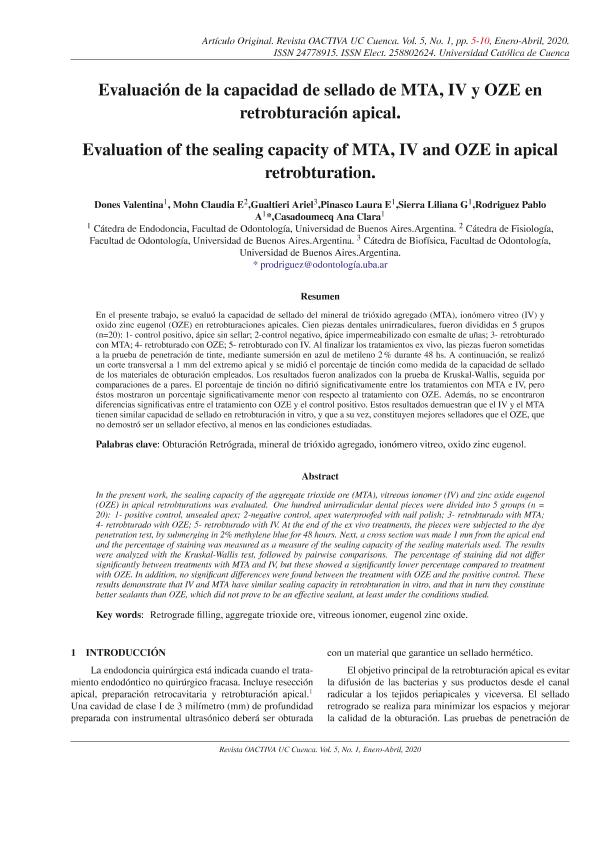Mostrar el registro sencillo del ítem
dc.contributor.author
Dones, Valentina
dc.contributor.author
Mohn, Claudia Ester

dc.contributor.author
Gualtieri, Ariel Félix

dc.contributor.author
Pinasco, Laura E,
dc.contributor.author
Sierra, Liliana Gloria

dc.contributor.author
Rodriguez, Pablo A.
dc.contributor.author
Casadoumecq, Ana Clara

dc.date.available
2020-07-27T14:53:51Z
dc.date.issued
2020-03
dc.identifier.citation
Dones, Valentina; Mohn, Claudia Ester; Gualtieri, Ariel Félix; Pinasco, Laura E,; Sierra, Liliana Gloria; et al.; Evaluación de la capacidad de sellado de MTA,IVyOZE en retrobturación apical; Universidad Católica de Cuenca; Odontología Activa; 3-2020
dc.identifier.issn
2477-8915
dc.identifier.uri
http://hdl.handle.net/11336/110323
dc.description.abstract
En el presente trabajo, se evaluó la capacidad de sellado del mineral de trióxido agregado (MTA), ionómero vitreo (IV) y oxido zinc eugenol (OZE) en retrobturaciones apicales. Cien piezas dentales unirradiculares, fueron divididas en 5 grupos (n=20): 1- control positivo, ápice sin sellar; 2-control negativo, ápice impermeabilizado con esmalte de uñas; 3- retrobturado con MTA; 4- retrobturado con OZE; 5- retrobturado con IV. Al finalizar los tratamientos ex vivo, las piezas fueron sometidas a la prueba de penetración de tinte, mediante sumersión en azul de metileno 2% durante 48 hs. A continuación, se realizó un corte transversal a 1 mm del extremo apical y se midió el porcentaje de tinción como medida de la capacidad de sellado de los materiales de obturación empleados. Los resultados fueron analizados con la prueba de Kruskal-Wallis, seguida por comparaciones de a pares. El porcentaje de tinción no difirió significativamente entre los tratamientos con MTA e IV, pero éstos mostraron un porcentaje significativamente menor con respecto al tratamiento con OZE. Además, no se encontraron diferencias significativas entre el tratamiento con OZE y el control positivo. Estos resultados demuestran que el IV y el MTA tienen similar capacidad de sellado en retrobturación in vitro, y que a su vez, constituyen mejores selladores que el OZE, que no demostró ser un sellador efectivo, al menos en las condiciones estudiadas.
dc.description.abstract
In the present work, the sealing capacity of the aggregate trioxide ore (MTA), vitreous ionomer (IV) and zinc oxide eugenol (OZE) in apical retrobturations was evaluated. One hundred unirradicular dental pieces were divided into 5 groups (n = 20): 1- positive control, unsealed apex; 2-negative control, apex waterproofed with nail polish; 3- retrobturado with MTA; 4- retrobturado with OZE; 5- retrobturado with IV. At the end of the ex vivo treatments, the pieces were subjected to the dye penetration test, by submerging in 2% methylene blue for 48 hours. Next, a cross section was made 1 mm from the apical end and the percentage of staining was measured as a measure of the sealing capacity of the sealing materials used. The results were analyzed with the Kruskal-Wallis test, followed by pairwise comparisons. The percentage of staining did not differ significantly between treatments with MTA and IV, but these showed a significantly lower percentage compared to treatment with OZE. In addition, no significant differences were found between the treatment with OZE and the positive control. These results demonstrate that IV and MTA have similar sealing capacity in retrobturation in vitro, and that in turn they constitute better sealants than OZE, which did not prove to be an effective sealant, at least under the conditions studied.
dc.format
application/pdf
dc.language.iso
spa
dc.publisher
Universidad Católica de Cuenca
dc.rights
info:eu-repo/semantics/openAccess
dc.rights.uri
https://creativecommons.org/licenses/by-nc-sa/2.5/ar/
dc.subject
OBTURACIÓN RETRÓGRADO
dc.subject
MINERAL DE TRIOXIDO AGREGADO
dc.subject
IONÓMERO VITREO
dc.subject
OXIDO ZINC EUGENOL
dc.subject.classification
Odontología, Medicina y Cirugía Oral

dc.subject.classification
Medicina Clínica

dc.subject.classification
CIENCIAS MÉDICAS Y DE LA SALUD

dc.title
Evaluación de la capacidad de sellado de MTA,IVyOZE en retrobturación apical
dc.title
Evaluation of the sealing capacity of MTA, IV and OZE in apical retrobturation
dc.type
info:eu-repo/semantics/article
dc.type
info:ar-repo/semantics/artículo
dc.type
info:eu-repo/semantics/publishedVersion
dc.date.updated
2020-07-01T17:03:15Z
dc.identifier.eissn
2588-0624
dc.journal.pais
Ecuador

dc.description.fil
Fil: Dones, Valentina. Universidad de Buenos Aires. Facultad de Odontología. Cátedra de Fisiología; Argentina
dc.description.fil
Fil: Mohn, Claudia Ester. Consejo Nacional de Investigaciones Científicas y Técnicas. Oficina de Coordinación Administrativa Houssay; Argentina. Universidad de Buenos Aires. Facultad de Odontología. Cátedra de Fisiología; Argentina
dc.description.fil
Fil: Gualtieri, Ariel Félix. Universidad de Buenos Aires. Facultad de Odontología; Argentina
dc.description.fil
Fil: Pinasco, Laura E,. Universidad de Buenos Aires. Facultad de Odontología; Argentina
dc.description.fil
Fil: Sierra, Liliana Gloria. Universidad de Buenos Aires. Facultad de Odontología; Argentina
dc.description.fil
Fil: Rodriguez, Pablo A.. Universidad de Buenos Aires. Facultad de Odontología; Argentina
dc.description.fil
Fil: Casadoumecq, Ana Clara. Universidad de Buenos Aires. Facultad de Odontología. Cátedra de Fisiología; Argentina
dc.journal.title
Odontología Activa
dc.relation.alternativeid
info:eu-repo/semantics/altIdentifier/url/http://oactiva.ucacue.edu.ec/index.php/oactiva/article/view/443
Archivos asociados
